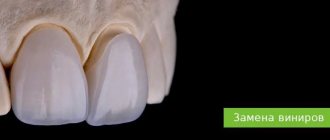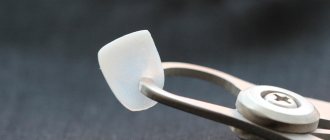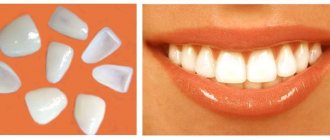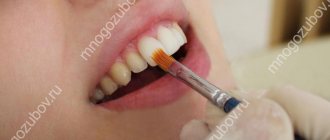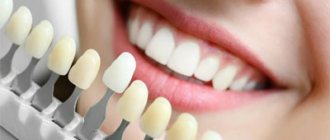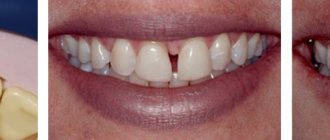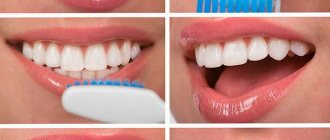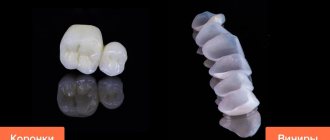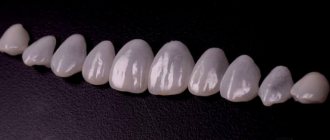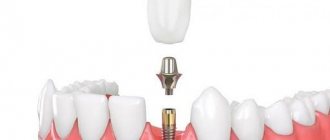Not all people can boast of perfect teeth, despite the fact that the standard of living is now much higher than in previous years and even centuries. Hereditary diseases, drug abuse, and injuries can sometimes cause problems and make smiles look unhealthy and unattractive.
But now such troubles can be dealt with with the help of veneers - thin plates that cover minor defects on the front of the teeth and correct their aesthetics. Installation of such overlays often requires preparation of the enamel, which does not seem like a wasteful action.
Benefits of veneers
All those shortcomings that dentists previously proposed to correct by installing crowns are now quite successfully masked with veneers. This:
- Cracks and chips in enamel;
- Darkening, spots;
- Areas with erosion of tooth enamel;
- Tetracycline teeth;
- Uneven cutting edges;
- A slight rotation of the tooth around the central axis, etc.
Emax veneers are considered the best aesthetic solution in microdental prosthetics. The surface of plates made of artificial material of natural origin reliably imitates the transparency, shine and color of human enamel, so those around them perceive the teeth as “native”.
Service price
Services for installing veneers with minimal grinding are provided by the best orthopedic dentists in Moscow. The cost of veneers with minimal grinding of teeth directly depends on the level of the clinic, the professionalism of the doctor and the selected material. This also includes the work of dental technicians and medical personnel.
The high cost is justified by the need for careful work to recreate the transparency of the enamel and its microrelief, the complexity of color transfer and restoration of the tooth structure.
Highly artistic veneers, invisible in the oral cavity, which look absolutely natural, cannot cost 30 thousand
rubles.
The price of such products starts from 50-60 thousand rubles. for one unit. Records made from aesthetic materials made in America will cost even more, however, they will last at least 15 years.
Why is preparation necessary?
Orthopedic treatment often requires the dentist to resort to grinding of the enamel. Such pre-treatment ensures the most durable attachment of the prosthesis to the surface of the tooth and its hermetically sealed coating. A few years ago, the procedure was painful and traumatic, which scared patients away and left bad memories. Nowadays, enamel preparation is performed using minimally invasive methods, using high-tech equipment, quickly and without experiencing painful sensations.
Nevertheless, patients continue to express concerns and ask whether this step can be avoided when installing veneers. However, in the vast majority of cases it is unlikely to be possible to completely avoid preparation. The reason is the high requirements for the quality of contact between the plate and the tooth. The surface of the enamel is never perfectly smooth; there are always microscopic tubercles, grooves, and depressions. If the veneer does not fit tightly, these cavities become the focus of bacterial masses.
In addition, the enamel is removed before the veneer is placed to reduce the final thickness of the tooth. When a plate is applied without preliminary preparation, the tooth will become larger and more massive, which will not beautify the smile and cause functional discomfort to the person.
The third reason for preparation will be a large amount of carious tissue. To eliminate the possibility of further damage to the tooth under the veneer shield, they will need to be removed.
But under some circumstances, when installing veneers, the dentist leaves the patient’s teeth intact.
Why is teeth grinding required?
In order for these plates to fit tightly to the tooth, the tooth itself needs to be prepared - ground. This is what scares most people who would like to install veneers. But what is the process of turning, or as it is called in dentistry, preparation, and is it so harmful to teeth?
Grinding before installing a veneer is the process of leveling the surface of the tooth by removing the top part of the enamel.
In addition to removing the top layer of enamel, during preparation for installation, the dentist must cure caries on the teeth being installed and remove hard plaque and deposits (professional teeth cleaning is almost always required).
When preparation for veneers is not necessary
Preparation of enamel is practically not required if a person has direct veneers made from composite mass. This is a special type of correction of the external surface, when the doctor layers a special material on the enamel. The procedure is performed in one clinic visit. However, composite veneers delivered without any treatment are still a rather rare case.
Ceramic veneers are made in a dental laboratory using a synthetic impression. Here it is important to tightly and firmly attach the plate to the tooth tissue, so grinding down the enamel is a necessity.
Exceptions to the rules when tooth preparation will only harm quality veneering:
- Visual correction of tooth rotation is assumed;
- Severe initial wear of the enamel;
- There are irregularities in the cutting edge of the tooth;
- The vestibular surface of the tooth requires thickening.
When installing any types of veneers - ceramics, porcelain, composite - you will have to remove the enamel if it is destroyed by caries. It is impossible to preserve the pathology under the veneer.
In exceptional cases, for example, when restoring a missing tooth wall, preparation as such is not performed. The doctor simply adds some roughness to the enamel so that the plate clings better to the surface being corrected.
How veneers are installed indirectly
All orthopedic structures in dentistry are made individually, taking into account the structural features of the jaw, the location of the teeth, etc. every patient. Since there are no universal onlays that would suit everyone, the process of making and installing veneers using the indirect method can take two or more weeks. Veneers are generally placed in six stages:
- Primary examination and diagnosis.
- Approval of the treatment plan.
- Fitting and adjustment of the layout.
- Preparation (turning).
- Manufacturing and fitting of veneers.
- Installation and fixation.
Each stage requires an individual approach, and the methodology itself requires the use of unique elements that are suitable only for a specific person. To understand how veneers are placed, it makes sense to take a closer look at the manipulations at each stage.
You might be interested in:
Veneers
Composite veneers
Ceramic veneers
E-max veneers
Artistic restoration of teeth
Initial examination and diagnosis
Occurs during the first visit to the clinic for the purpose of further installation of veneers. At this stage, the following must happen:
- Oral examination
. In order to determine the scale of the problem and the level of tooth decay that requires restoration. At the same time, possible preliminary procedures are determined (for example, cleaning tartar, eliminating caries, etc.). Based on the general condition, an anamnesis is collected. - Confirmation of indications and verification of the absence of contraindications
. Veneers, as an option for artistic restoration, are not indicated for all dental defects. After examining the oral cavity, the dentist accurately determines whether veneers are suitable for solving the problem or whether other types of restoration should be preferred. In addition, the doctor must find out whether there are any contraindications. - Collection of analyzes
. Depending on the situation, this may include referrals for an X-ray or CT scan. The data obtained will allow the specialist to determine the condition of the bone tissue as accurately as possible and identify possible pathologies in order to prevent and/or prevent complications after the procedure. - Study of facial anatomy
. The dentist carefully examines the face as a whole, as well as specifically the mouth and lips and their relationship to the teeth. Very often at this stage photographs of the oral cavity are taken - the pictures will be used to draw up an individual treatment plan. - Discussion of the desired result
. Since beauty is a purely subjective concept, it is necessary to determine what aesthetic effect is expected by the patient. This is especially important in cases where overlays are needed not for 1-2 teeth, but for the entire smile area. Right now the desired shade and other cosmetic nuances are being discussed. - Scanning and impressions
. Depending on the situation, for further production of individual onlays, silicone impressions are made or, using an intraoral scanner, digital scanning is carried out. The data obtained is necessary in order to create a diagnostic model as accurately as possible and study the characteristics of the bite in detail. This data will also be used in the future for digital computer modeling.
When planning to install orthopedic structures, as an example and visual aids, you can provide photos of smiles that you like, asking to achieve the same result. If in doubt, you can always consult your doctor, who can give professional advice and offer the best options for the shade of veneers and other technical nuances.
Treatment plan approval
After collecting information during the initial examination, the specialist you contacted, in order to obtain the best desired effect, involves dentists of various specialties (for example, a hygienist, an orthodontist, a periodontist and an implantologist) in developing a treatment plan. Through joint efforts, the most effective solutions for a particular patient are determined. Thus, on your second visit to the clinic, you are provided with a complete treatment plan with an explanation of all its points. Based on the proposed option, you can ask any questions and ask for clarification on all the nuances related to how to install orthopedic structures.
Trying and adjusting the layout
Once the treatment plan is approved, a digital project will be ready within a week (or in some cases 10 days). You can see what your future smile will look like in a photo printed on a 3D printer.
The proposed option can be adjusted not only visually, but also practically - based on the 3D model, fitting plastic overlays are created that can be inserted into the mouth without preliminary turning or other manipulations. This will allow you to evaluate how the previously approved layout will look when you smile.
In order for patients to have the opportunity to “try on” new teeth, an impression is taken from the diagnostic model, which is a “silicone key”. It is filled with liquid plastic and placed in the oral cavity. After hardening, the “silicone key” is removed, and an exact copy of the future veneers remains in the patient’s mouth. This manipulation is called MOCK-UP.
This allows you not only to evaluate the future result from the outside, but also to make possible and necessary adjustments - ask to change the shape or size. At this stage, a discussion is held until the plan is fully approved - the desired adjustments are made to MOCK-UP (the material of the try-on veneers is easily adjusted and all “edits”, according to wishes, are made on the spot).
Once the mold has been finalized, a digital impression of the MOCK-UP is taken by scanning to create the exact same permanent veneers. In this case, the installation guarantees the most suitable version of orthopedic structures for your anatomical features.
Preparation (turning)
Approval of the shape, size and color of future veneers is the reason to begin the next stage of treatment - preparing the teeth for the installation of onlays. This requires turning (sawing) from the outside. The volume of tissue to be cut is determined individually and depends on the position of the teeth and the desired result. Before veneers are placed, grinding is mandatory for all patients without exception.
Since the turning procedure is uncomfortable, it is performed under anesthesia of your choice:
- punctual (an injection familiar to everyone);
- computer;
- drug-induced sleep (general sedation).
The last option is most often used when it is planned to install veneers over the entire smile area. Regardless of the anesthesia option chosen, turning, as a procedure requiring maximum precision, is performed using binoculars and an operating microscope.
After grinding, the gums are retracted - a special thread is installed into the gingival crevice (to clearly define the boundaries). This is required for more accurate production of veneers. After this, a scan is performed or silicone impressions are made.
At the end, temporary (adaptation) veneers are installed and fixed, which will protect the ground teeth and help you get used to your new smile. The service life of such linings is from two weeks to a couple of months. This time is enough to make permanent overlays.
Manufacturing and fitting of veneers
Some people are interested not only in how veneers are placed, but also in how they are made. It will not be possible to watch the process, since outsiders are not allowed to enter the dental laboratory. But, we are ready to talk about this process step by step:
- After receiving impressions, plaster models are cast.
- The resulting layout is digitized. To do this, a plaster cast is placed in a laboratory scanner and turned into a computer model.
- The dental technician begins to compare the actual situation with the desired result (based on the data obtained in the previous stages).
- Using a special computer program, the technician models future overlays.
- The finished model in the form of data is sent to a high-precision milling machine, which mills veneers from a ceramic blank block.
- The finished overlays are painted in a specified color and placed in special ovens for baking at high temperatures.
After this, fitting is carried out at the next appointment with the doctor. The overlays are fixed with try-on gel. This procedure allows you to evaluate the quality of fit, the resulting color and the degree of transparency.
Installation and fixation
Finally, the permanent veneers are installed and secured using a special adhesive to ensure a tight bond to the teeth. Thus, the long service life is guaranteed not only by the strength of the ceramic from which the onlays are made (its strength is several times greater than that of tooth enamel), but also by the solidity of their fixation. The installation itself looks like this:
- anesthesia is administered to avoid discomfort during the procedure;
- temporary overlays are removed;
- protection from moisture is provided in the place where the installation will be carried out (for this, a special thread or rubber scarf is used);
- the teeth are treated with an antiseptic, and then a special gel is applied to them, which is necessary to remove microorganisms and will provide enhanced fixation;
- The gel is washed off and the installation sites are dried;
- Special glue is applied to the teeth and veneers and the onlays are installed in their places;
- Special lamps are used to harden the glue.
After the veneers are installed, a routine examination will be required by the attending physician, who will assess the condition of the gums and, if necessary, perform spot grinding along the bite. Based on the results of this examination, recommendations for professional hygiene and oral cleaning will be issued.
What happens if you install an Emax veneer without grinding?
A doctor who cares about his own reputation will never agree to glue a veneer without preparation if he is absolutely sure that treatment is necessary. The patient should trust a qualified specialist to be satisfied with the result. Let's try to imagine what will happen if you put a veneer on a solid tooth in violation of the technology requirements:
- Significant darkening will remain visible even through the surface of the Emax veneer. Thin lumineers are especially translucent, so even when choosing these expensive porcelain onlays, turning is sometimes required.
- Despite the relatively small thickness of the ceramic plate, it still looks bulky on unprepared teeth: it adds volume, looks unnatural, and sometimes even interferes with articulation and chewing of food.
- A ledge often forms above the Emax veneer, near the gums, where plaque and bacteria accumulate. Pathogenic flora is also able to penetrate between the surface of the tooth and the plate itself. In such gaps it develops unhindered, causing caries and its complications.
Many patients are misled by advertising articles that say that it is possible to remove Emax veneers from unground enamel and thereby return the teeth to their natural appearance. This statement is erroneous, since veneers made from this material are relatively thick, and therefore always require paring, unlike ultra-thin veneers without grinding Luxneers and American lumineers (Lumineers).
Zirconium dioxide veneers
Zirconium veneers are highly durable and can withstand the most severe loads. The microprosthesis frame is made from zirconium blocks and then covered with ceramic mass to achieve maximum naturalness and aesthetics of the veneers. One of the disadvantages of zirconium veneers is their high cost.
The cost of a zirconium veneer for one tooth in Moscow is 50,000 rubles.
Knowing the cost of one microprosthesis, you can estimate the cost of installing veneers on the teeth whose appearance you want to change. Typically, restoration with veneers is done only in the smile zone, which includes 10 upper teeth and 8 lower teeth. But the best way to find out how much dental veneers cost is to visit your doctor's office for an examination and diagnosis!
Preparation methods
The latest methods of grinding down enamel to install artificial overlays involve gentle processing technology and high-precision equipment.
Laser method
A beam of polarized light acts on the hard tissues of the tooth. The moisture contained in them evaporates, and many hydraulic shocks occur, as a result of which the enamel is destroyed.
The advantages of the technique are the speed of impact, the absence of pain and the silent operation of the laser system. It is no secret that the buzzing of a drill is considered one of the most unpleasant auditory stimuli. There is no need for preliminary sanitation of the oral cavity, because the laser perfectly burns out all microflora in the treated areas.
It should be noted that working with a laser requires a steady hand and high qualifications from the dentist, and the professionalism of a specialist is usually well paid. In addition, laser treatment is superficial. If, for example, caries penetrates deep into the enamel, additional exposure will be required.
Ultrasonic treatment of enamel
Ultrasonic treatment of enamel also does not involve preliminary anesthesia - except in extreme cases, with tooth hypersensitivity. Under such exposure, tissues do not overheat and are not destroyed excessively - only within the required limits. Many doctors consider ultrasound as most appropriate in preparation for veneering.
Install veneers without grinding Luxneers teeth at Dr. Lopaeva’s clinic
Make an appointment
Or call +7(985)532-21-01
Chemical treatment of teeth
Preparation of enamel using this technology includes treating teeth with softening pastes. As a result, the outer tissue is easily removed. The disadvantage of this method is the duration of the procedure: the chemical composition requires time to act, approximately 30 minutes.
The advantages are significant:
- Painless;
- No overheating or thermal injury to tissues;
- The risk of excess enamel chipping and cracks is eliminated.
Tunnel preparation method
Grinding using this method will require the use of a special turbine unit. The doctor uses a multi-speed bur with a diamond tip. This treatment is used more often than others and allows for extremely precise control of the degree and depth of impact on the enamel.
The disadvantages of the procedure include pain (anesthesia is required) and increased requirements for equipment. The turbine greatly overheats the tooth tissue. If the device does not have a special cooling device, the patient will be injured. If you work carelessly with a bur, damage to soft tissues is possible - the dentist should not be distracted by anything while working.
Air abrasive method
This method is used only for treating the outer layers of tooth enamel and is used in combination with other methods. The principle of operation of a special installation is to influence the tooth with abrasive powder ejected under pressure. The enamel is removed painlessly and quickly. In this case, it is possible to avoid excessive heating of the organ tissues.
The choice of tooth preparation technology can be planned in advance during a consultation with a doctor. Not every clinic has the full range of equipment; the condition of the patient’s oral cavity and his individual reaction to the technique are also taken into account.
Disadvantages of installing plates without turning
Veneers without grinding have a number of disadvantages. These include: increased tooth thickness, which seriously affects aesthetics, the risk of serious problems during wear, and the impossibility of eliminating all defects.
In order for the veneers to adhere better, the surface of the enamel must first be etched with a special acid, as a result of which its appearance will be seriously and irreversibly changed. In the future, plates will definitely have to be installed on such teeth. The small thickness of lumineers cannot completely hide all shape defects.
Preliminary grinding ensures the creation of a smooth and high-quality transition into dental tissue. Installation without grinding provokes the formation of caries, plaque accumulation and gum inflammation.
Stages of preparation for Emax veneers
- Making horizontally directed depressions on the vestibular part of the tooth, which determine the extent of penetration into the enamel. The depth is controlled using a diamond bur. The treatment boundary is prepared to the gum, including the lateral surfaces.
- Carefully remove the enamel layer to a depth of no more than 1 mm. Sometimes it is necessary to thoroughly intervene in living tissue if the carious lesion is extensive. The integrity of the cutting edge of the teeth is also affected.
- The prepared area is polished, coated with a degreasing agent, thoroughly washed and dried. Before the final installation of the veneer, the tooth surface is etched with a special chemical composition that increases the adhesion of the surface to the prosthetic material.
Veneers for front teeth - indications for use
Veneers cannot be made on all teeth, but only on the 10 upper front teeth, as well as the 8 lower front teeth. These limitations are associated with too high a chewing load in the area of large chewing teeth. Veneers on the front teeth can correct:
- chipping of the cutting edge (Fig. 4),
- unattractive tooth color that cannot be improved by chemical whitening (Fig. 5),
- the shape of the teeth is not beautiful enough,
- spaces between teeth (Fig. 6),
- moderate crooked teeth that you want to correct without orthodontic intervention.
Ceramic veneers: before and after photos
Preparation for ceramic veneers
Ceramic veneers today are unrivaled if we analyze the demand for correction of the smile area with artificial overlays. Silicon oxide-based structures are durable, and their ability to reflect light rays is similar to the properties of natural enamel. Therefore, ceramic veneers are indistinguishable from real teeth.
The big advantage of these products is their resistance to staining and oxidation by food compounds, as well as a long service life compared to composite plates.
There is no single preparation algorithm for the installation of artificial onlays. The process is invariably individual and will differ for each patient. The procedure depends on the type of veneer - direct or indirect, on the location of the tooth in the patient’s mouth, on the presence of carious lesions and the volume of fillings.
Failures are not excluded in veneering. One of the factors of poor aesthetics of installed plates is improper preparation of the enamel. This is done in two ways:
- An indirect method used when installing similar veneers. Such plates cover the entire outer surface of the tooth, so it is important to remove the enamel so that the adhesion of the veneer and the prepared surface occurs perfectly. If the layer is removed too finely, the effect of horse teeth is possible, when the veneer makes the tooth visually massive and unnatural.
- The direct method is used when placing direct composite veneers. Here, it is often not necessary to completely remove the enamel; it is enough to expose individual areas.
There is no need to worry about preparing the enamel before installing the veneer. Today, the action is performed carefully in relation to living tissues and is completely painless. A thoughtful choice of clinic and specialist will be the key to high-quality installation of veneers and your healthy and beautiful smile.
Do you want to get professional advice on veneers?
Always at your service - Sergey Samsakov, orthopedic dentist with more than 10 years of successful experience, Moscow. Expert in 3D digital smile modeling, veneers and CEREC technology.
Patients come to me from all over Russia:
General principles of stitching
When grinding for veneers, the orthopedic dentist is guided by the minimum need, as well as the condition of the tooth itself on which the inlay is installed. This is due to the fact that a high-quality connection between the plate and the stump is possible only in the presence of tooth enamel, which is why it is so important to preserve it.
But it will also not be possible to keep it completely intact, since the artificial element has its own thickness, which increases the size of the tooth, and the connection in this case will be unreliable.
Preparing teeth for veneers provides the following effects:
- fixes the plate efficiently;
- masks the connection point;
- maximizes service life;
- reduces the risk of damage to the product.
Installation of artificial elements can be done without turning, but, as a rule, such prosthetics are carried out to eliminate any minor cosmetic defects and such a prosthesis will not last for a long time. That is why the vast majority of dentists first fully process the tooth enamel and only then fix the plates.
Installation principle
Modern onlays - lumineers and ultraneers - do not require preparation. To install them, you only need to roughen the enamel. But they also cost an order of magnitude more.
